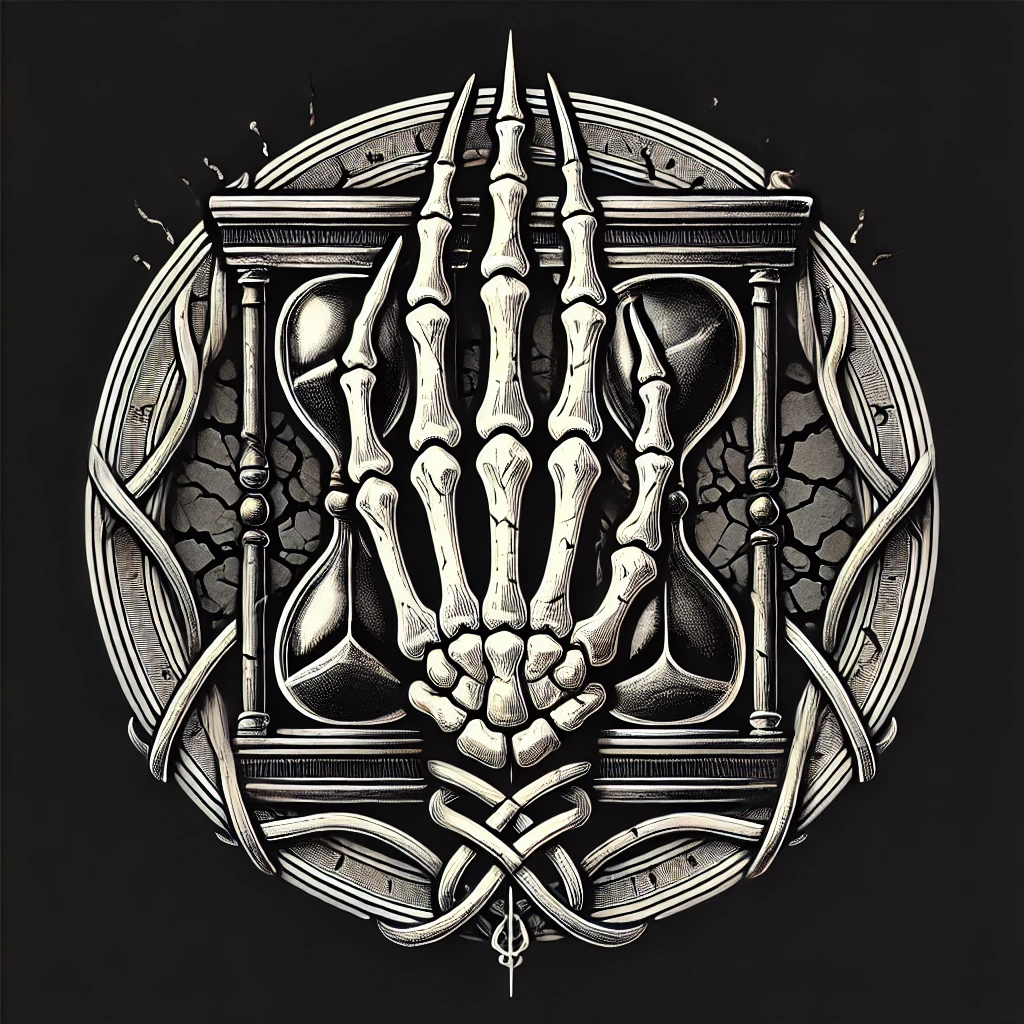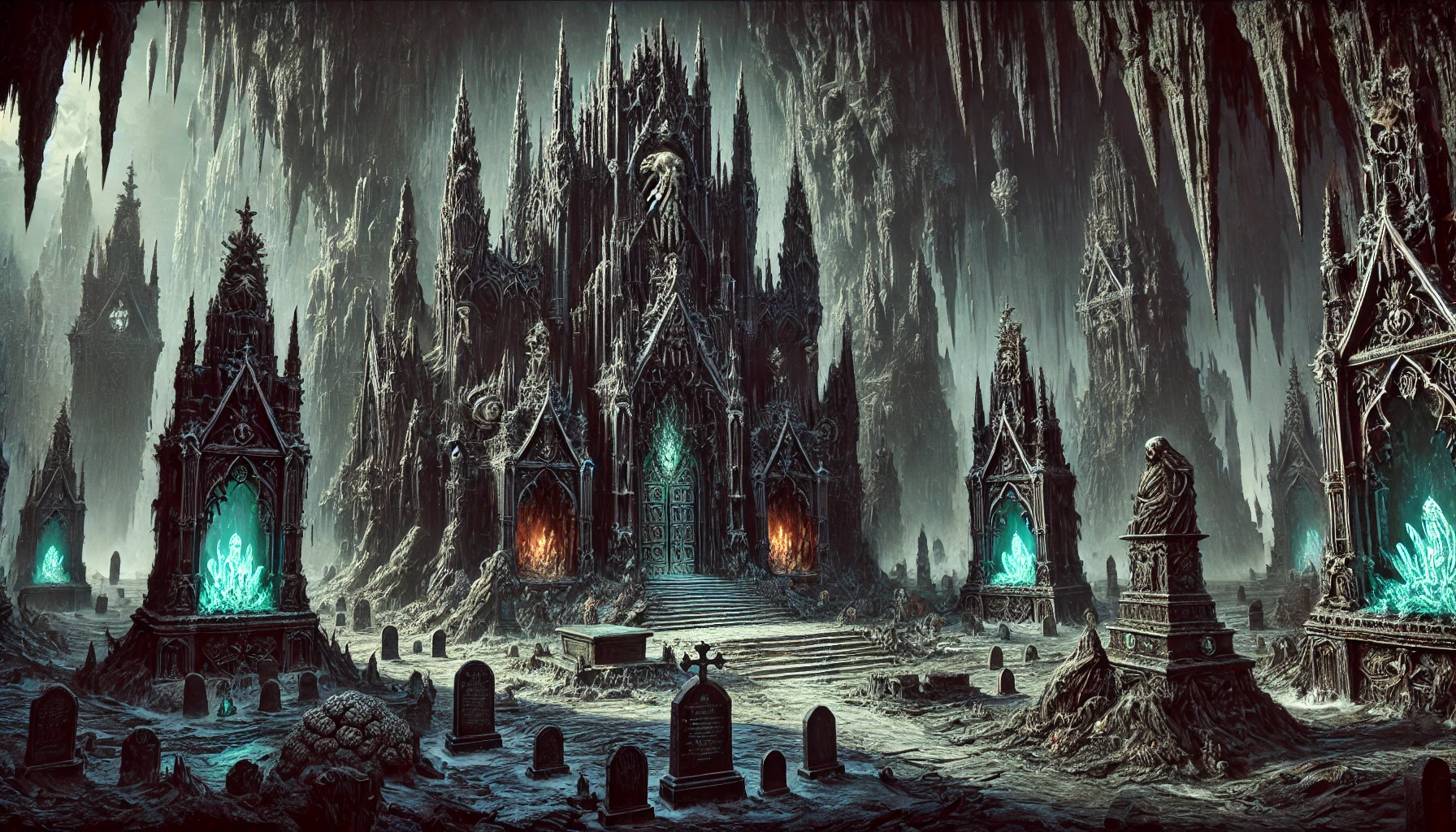The Keepers of the Last Breath
The Keepers of the Last Breath are a solemn and revered religious order dedicated to the preservation of death's sanctity and the natural balance between life and endings. They venerate Viso, The Reaper, a deity embodying death, destruction, and fate, whose impartial hand ensures the cycle of existence flows undisturbed. Guided by the belief that death is not an adversary but a necessary transition, the Keepers serve as stewards of funerary rites, protectors of sacred burial grounds, and counselors to the grieving. Their influence spans Dolviar, offering solace in times of loss and reminding mortals of life's fleeting beauty.
At the heart of their faith is the understanding that every life, no matter how brief, is a thread in the grand tapestry woven by Viso. The Keepers uphold this philosophy through their daily rituals, which include meditations on mortality, silent vigils, and the maintenance of crypts and mausoleums known as Halls of Silence. These hallowed places are more than mere resting grounds; they serve as centers of reflection and peace, where mortals can confront and embrace the inevitability of death. The order’s priests, distinguished by their muted robes and skeletal-hand insignia, are both spiritual guides and defenders of the sacred, opposing necromancy and any attempt to disrupt the natural cycle.
Despite their solemn demeanor, the Keepers of the Last Breath are not without compassion. They strive to ease the fears of the living and honor the memories of the departed, viewing their work as a sacred duty rather than a grim burden. Yet, in the aftermath of the Great War of the Gods and Viso’s enigmatic silence, the Keepers find themselves at a crossroads. They continue to fulfill their roles, but the absence of divine guidance has led to growing uncertainty and fear among the faithful. In these challenging times, the Keepers stand as unwavering sentinels of balance, their actions a testament to the enduring power of belief in a world scarred by loss.
Structure
High Veilkeeper (Leader):
The head of the Order, responsible for overseeing its philosophy, doctrine, and major decisions. Often resides in the grandest Hall of Silence.
Elders of the Veil:
A council of senior priests and scholars advising the High Veilkeeper. They maintain sacred texts and adjudicate disputes within the Order.
Deathwardens:
Guardians of burial grounds and protectors of sacred rituals. Skilled in combat and often serve as temple defenders.
Mourners of the Veil:
Priests specializing in grief counseling and funerary rites. They work closely with communities to ensure proper respect for the dead.
Keepers of the Final Word:
Mystics trained to use the Veil of the Last Breath to commune with the dead, ensuring closure and resolving unresolved conflicts.
Initiates of the Veil:
Novices who undergo rigorous training in the Order’s philosophy, rites, and combat skills before ascending to higher ranks.
Culture
Core Beliefs:
Death is sacred and necessary, not to be feared or disrupted.
Every life deserves remembrance; every death deserves dignity.
Necromancy and the defilement of death are ultimate blasphemies.
Customs:
Daily meditation on mortality.
Wearing muted or black robes symbolizing humility and focus on the eternal.
Quiet and reflective demeanor, avoiding frivolity or loud displays.
Community engagement through grief support and remembrance ceremonies.
Public Agenda
To ensure the sanctity of death and maintain balance in the cycle of life and endings.
To educate and guide communities in understanding mortality, offering solace in times of loss.
To prevent defilement of the dead and safeguard burial grounds
Assets
Temples and Crypts: The Halls of Silence, grand mausoleums that serve as temples and burial sites.
Artifacts:
Scythe of the Final Sunset.
Veil of the Last Breath.
Silver and Gold: Donations from wealthy patrons or community offerings.
Deathwardens: Trained guardians equipped with sacred weapons.
Sacred Texts: The Silent Testament and Codex of Passing.
History
2nd Era, 1451 AE: The Order was founded during a time of widespread chaos and lawlessness, offering structure and dignity in the face of death.
3rd Era, 851 AE: The Scythe of the Final Sunset was gifted to the Order by a mysterious entity, believed to be an avatar of Viso.
The Great War of the Gods (4th Era): The Order played a crucial role in preserving burial grounds and performing death rites for fallen soldiers.
Post-War Silence: The Order experienced a crisis of faith due to Viso’s absence, adapting their practices to emphasize self-reliance and mortal responsibility.
Disbandment
N/A: While weakened in influence and numbers, the Order remains a vital part of Dolviar’s spiritual fabric.
Mythology & Lore
The First Death: The foundational myth states that before Viso’s arrival, life was eternal but stagnant. Mortals knew no end, and the world became crowded and chaotic. Viso descended and claimed the first life, introducing death to the cycle of existence. While this brought sorrow, it also allowed for renewal and meaning, teaching mortals to cherish their fleeting time.
The Weaver of Ends: Another myth describes Viso as a cosmic weaver who threads every life into the grand tapestry of existence. Each death is not a loss but a thread completed, woven into the greater whole.
The Trial of Eternity: A tale of a warrior who defied Viso and sought immortality. His defiance caused untold suffering as the balance was disrupted, leading to the fall of his kingdom and the eventual realization that even eternal life without purpose is a curse.
Divine Origins
The religion emerged during the 2nd Era, when communities faced plagues and societal collapse. Early mortuary practices evolved into rituals honoring death, and the first Halls of Silence were built to serve as sacred spaces for the dead. Teachings about Viso coalesced around oral traditions and visions experienced by early priests.
Cosmological Views
The Cycle of Ends: The Keepers believe the world exists in an endless cycle of creation and destruction, with death acting as the fulcrum between these states. Life flows into death, which in turn nourishes new beginnings.
The Loom of Eternity: Viso is seen as the weaver of all fates, ensuring that no life is forgotten, no matter how brief or inconsequential.
The Shadow Beyond: After death, souls are believed to traverse a shadowy plane where they are judged by Viso. Those who lived in harmony with the cycle are peacefully woven into the tapestry of existence, while those who defied it face spiritual disintegration.
Tenets of Faith
All Things Must End: Death is not an evil but a necessary part of existence.
Honor the Dead: Preserve the dignity of the deceased and respect their memory.
Defile Not the Cycle: Necromancy and defiance of fate are blasphemies against Viso’s will.
Cherish Life’s Impermanence: Life’s fleeting nature makes it precious; live with purpose and humility.
Guard the Balance: Creation and destruction are interwoven; both must coexist in harmony.
Ethics
Pious Acts:
Tending to burial sites and honoring the dead.
Providing solace to grieving families.
Acts of sacrifice or service that uphold the natural balance.
Sins:
Practicing necromancy or disturbing graves.
Fear-driven denial of mortality, such as reckless pursuits of immortality.
Defiling sacred spaces or disrupting the Order’s rituals.
Worship
Daily Practices:
Meditations on mortality, silent prayers, and the lighting of incense or candles.
Rituals:
Rite of Final Passage: A solemn funeral procession, ending with the interment of the deceased and prayers to Viso.
Day of Last Light: An annual day of remembrance where families honor ancestors with offerings.
Symbols in Worship:
Fading flowers, hourglasses, and skeletal motifs.
Priesthood
The Order of the Last Veil oversees the faithful. Its priests are scholars, spiritual counselors, and protectors of the dead.
Appointment:
Novices (Initiates of the Veil) undergo rigorous training in philosophy, combat, and ritual practice. Ascension to higher ranks is determined by demonstrated understanding and devotion.
Distinction:
Priests wear robes of deep black or gray adorned with subtle hourglass motifs. High-ranking members carry the Veil of the Last Breath or symbolic scales.
Granted Divine Powers
Death’s Grace Level 1: At the start of their journey, the character gains a passive ability to sense disturbances in the cycle of life and death. This ties to their connection with the divine and sets the tone for their role.
Final Peace Level 4: By this level, the character has enough experience to interact with the natural flow of life and death. Easing the passing of a dying individual or calming restless undead is a fitting progression of their abilities.
Voice of the Departed Level 7: The Veil of the Last Breath becomes available, allowing the player to commune with spirits. This provides utility and roleplaying opportunities without being overpowered, fitting the mid-level narrative growth.
Balance of Fate Level 10: Limited divination abilities to foresee life-ending events should come as the character nears mastery of their spiritual connection. This ability can provide vital clues or foreshadow major plot events.
Reaper’s Aegis Level 15: At this level, the character gains the ability to shield allies from death itself. Once per long rest, they can intercept a lethal blow or an effect that would cause death, negating the damage or effect entirely and allowing the target to continue fighting. This power embodies their role as a guardian of the balance of life and death.
Political Influence & Intrigue
The Order is neutral but influential, as their guidance is sought in matters of succession, funerary rites, and crises involving death (e.g., plagues or necromancy).
Alliances:
The Order often aligns with factions or rulers who respect their neutrality and the sanctity of death.
Opposition:
They face hostility from necromancers, some political groups that view them as overly rigid, and individuals who see them as agents of fear.
Sects
The Pure Veil:
A highly traditionalist faction focusing strictly on rites and rejecting any adaptation of practices. They view modernization as a corruption of Viso’s will.
The Shadows of Balance:
A controversial sect that sees destruction as an active duty, taking steps to end lives or situations they deem "imbalanced." They are often at odds with the main Order.
The Weavers’ Circle:
A mystic sect focused on interpreting fate and divining Viso’s will through meditative practices and the study of The Silent Testament.

"In Silence, We Find Peace.", "Every End Is Sacred."
Circa 2nd Era, 1451 AE (After Emergence): Founded shortly after the first Halls of Silence were built, during a period of societal unrest where the need for orderly death rites became vital. - N/A: The Order remains active, though diminished in influence after the gods’ silence following the Great War.
Remove these ads. Join the Worldbuilders Guild









Comments